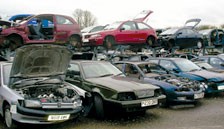Scrappping cars used to be simple. Pile them high, crush them small. But with increasing focus on environmental issues, the industry has had to become more professional, with the recycling of parts a growing business.
Since the beginning of 2006, the End of Life Vehicle regulations put in place by the European Union have decreed that recycling targets of 85%, by weight, per vehicle, are achieved, although for vehicles built before 1980, this level drops to 75%.
Hitting this target requires more than just recycling the metal, though.
In most cars, the metal element of the weight will account for around 75% of the waste, so the next 10% must come from recycling plastics and fluids.
By 2015, manufacturers will have to recycle 95% of cars.
Scrapping cars today is big business. More than 60,000 Ford vehicles alone will be recycled this year by 150 dismantlers.
To become an approved dismantler, you must be accredited by the Environment Agency and there are currently about 1,400 authorised treatment facilities (ATFs).
John Kingston, environment manager for Honda (UK), says: “Manufacturers were concerned when the End of Life Vehicle Directive was being discussed that the responsibility for dealing with these cars would cost them a lot of money that would then end up being passed onto the consumer.
But the high prices globally for steel – even in scrap form – over the past few years has softened the blow considerably.’
- Read this story in full in the 5 September 2008 issue of AM. To subscribe to AM magazine click here or call 01733 468659.














Login to comment
Comments
No comments have been made yet.